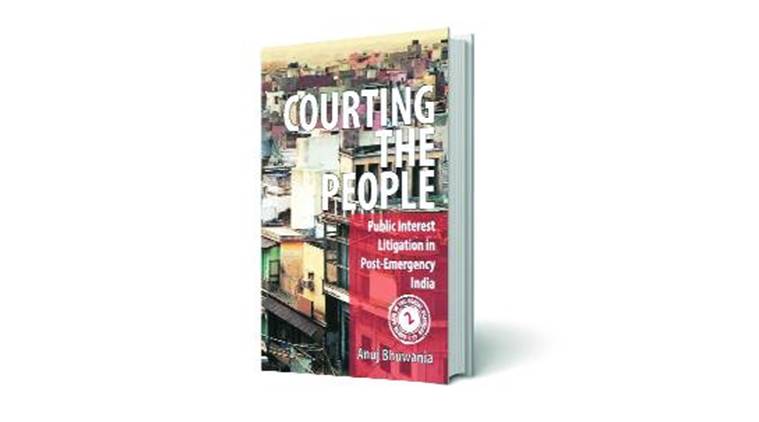Matters of Interest
The PIL has benefitted the bourgeoisie, lawyers and judges, apart from the poor for whom it was intended.
 ‘Courting the People: Public Interest Litigation in Post-Emergency India’ by Anuj Bhuwania, Cambridge University Press.
‘Courting the People: Public Interest Litigation in Post-Emergency India’ by Anuj Bhuwania, Cambridge University Press.
Public Interest Law (PIL) was a divine gift which the Supreme Court gave unto itself. It was hated by the marble miners of Sariska, the magnate of Niyamgiri, the timber merchants of the Northeast, the displacees of Narmada, the tribals of Jharkhand, employers of bonded labour, the slum and jhuggi dwellers and rickshaw pullers of Delhi, the many down-and-outs whose livelihood and right to life were threatened, politicians and businesses exposed for corruption, the administration, the police and others. My “who-hates-PILs” test is one way to gauge the success, failure and unruliness of PIL. The corresponding “love” test includes chest-thumping judges, PIL lawyers, those appointed to inquiry and implementation commissions, competing businessmen, the middle class, which wanted to get rid of slums and jhuggis, and bourgeois environmentalists. This consequentialist “love-hate” divide will go some way towards identifying the nature of PIL. This book will help you to balance the good and evils of PIL from a consequentialist point of view to produce startling results. One day, I hope this stark balance sheet will be fully drawn up.
Watch What Else Is Making News
PIL provided redemption to the judiciary after its much-denigrated failures during the Emergency. The ideas came from VR Krishna Iyer, it was sculpted by PN Bhagwati and carried through by O Chinnappa Reddy, DA Desai and YV Chandrachud. It widened rules of locus (so that more people could approach the higher judiciary) and provided for investigative and monitoring committees which acculturated power to themselves. That it was not adversarial is something of a joke. All cases were heavily contested, more by the “haves” than the “have-nots”. Not surprisingly, PIL became popular in Pakistan, Nepal, Bangladesh and Sri Lanka, attracting public, journalistic and academic attention.
Bhuwania’s book pulls down the benign mask of PIL, inviting us to gaze upon what he calls ‘omnibus’ PILs. A PIL on garbage disposal was directed against slum dwellers who were portrayed as “pickpockets” of public land. PILs transited to removal of jhuggi and jhopri dwellers and clearing the banks of the Yamuna occupied by the poor. Out of nowhere, the Supreme Court began sealing shops in Delhi. It ignored legislation designed to stop it. PIL was a dream run in the High Court for Justice Vijender Jain and his oversight appointees. The Supreme Court’s forest case of 1996 traversed three decades, armed by court committees and the amicus curiae, Harish Salve — both of whom have a lot to answer for; as also Ranjit Kumar in the sealing cases. In the ‘omnibus’ cases, the relief sought was narrow, but judges expanded it to go in any direction they wanted.
The question of accountability was answered by Upendra Baxi by making a distinction between “social action litigation”
(SAL, originating and drawing synergy from society), and PIL (which could be a plaything in anyone’s hand). The litigation bearing Baxi’s name was more PIL than SAL, though he advocated the latter. My cases, such as the one against the marble mining companies in the Sariska tiger reserve, worked closely with locals. The other trend of PIL cases launched by persons (or vehicles specially created by them) is exemplified by Prashant Bhushan, who presented many cases on whatever he liked as representing the public interest. This does not detract from his many achievements. As lawyer pioneers of PIL, Indira Jaising, Gobinda Mukhoty and Sanjay Parikh aided many social movements including the Narmada Bachao Andolan, with which Bhushan was also involved.
Be that as it may, the PIL was a judge-led phenomenon. The judiciary adopted three ways of dealing with PIL. The first, adopted by some judges, was to disown it. Markandey Katju called it a “Frankenstein”, even though he himself (suo motu) created a PIL exhorting the government to turn sea water into potable drinking water. The second was that some judges claimed they had cleansed PIL by disallowing “paisa interest” and “publicity interest” litigation. But that too was randomly applied to make politician Subramanian Swamy a self-styled prince of PIL. The third way asserted that courts were doing no more than remedying failures of governance in the public interest.
PIL rewrites the doctrine of separation of powers, precipitating a power struggle with the executive and parliament. It is not as if “public interest” causes were not achieved through ordinary litigation. Indeed, the Basic Structure case (1973) was one instance. But PIL remains a creative addition to governance. A key problem is that it is temperamental, unpredictable and class-biased. It needs to get its act together. The jallikattu controversy also reminds judges not to go beyond what they can implement.
Intended for the poor, the PIL has become self-serving, for the bourgeoisie, lawyers and judges themselves. Bhuwania’s book takes us to ground realities with theoretical insights. A wonderful book for many reasons. One of them fulfills the citology test: if the bibliography and index carry my name, it is a good book. In this, too, Bhuwania passes the test.
The writer is a senior advocate at the Supreme Court.



- 01
- 02
- 03
- 04
- 05
























